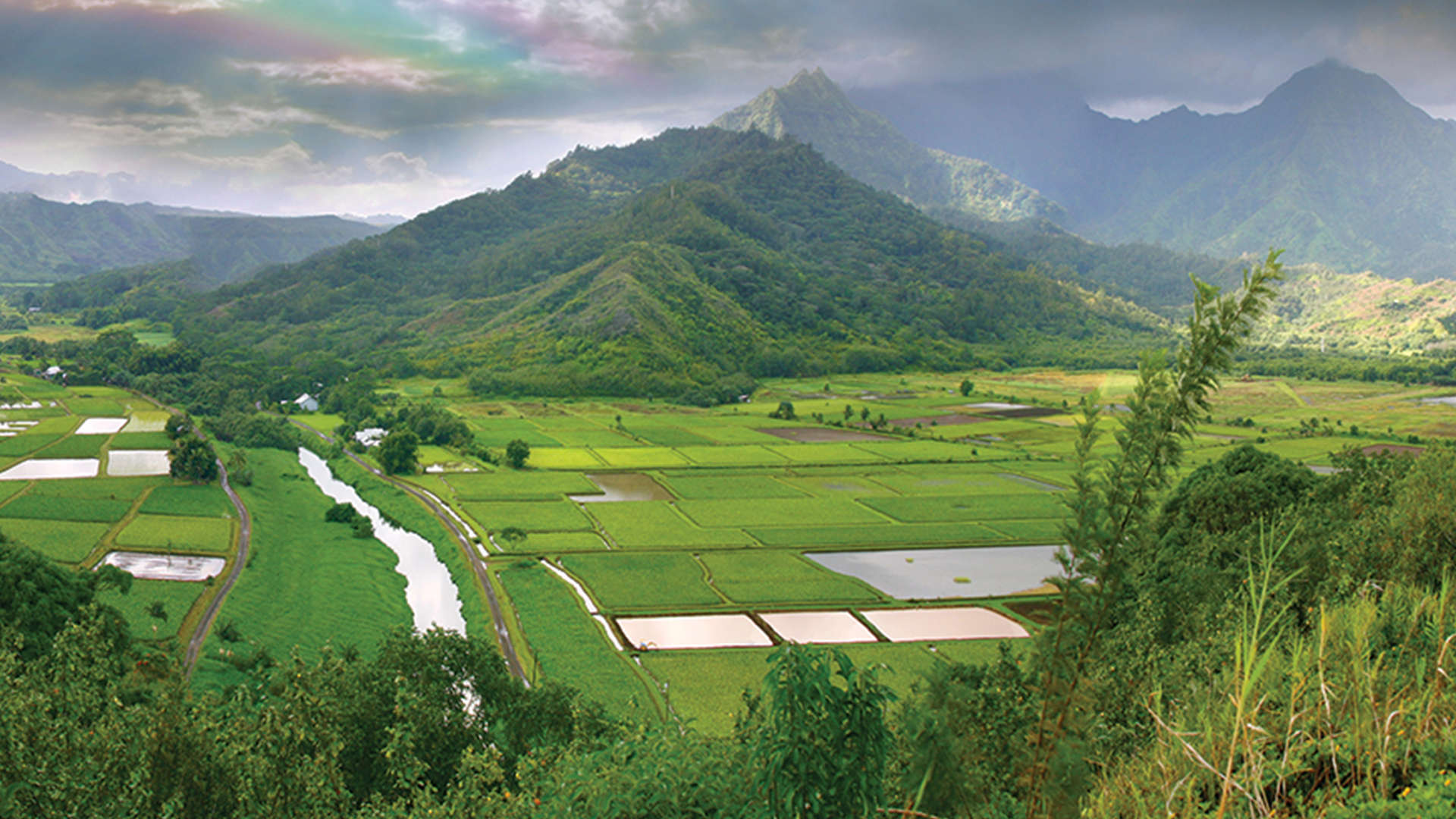
Hawaiiana
The Hawaiian Language, The Early Settlers, the Meanings of Names, Early History of Kauai, Hawaiian Royalty, Plantation Days.
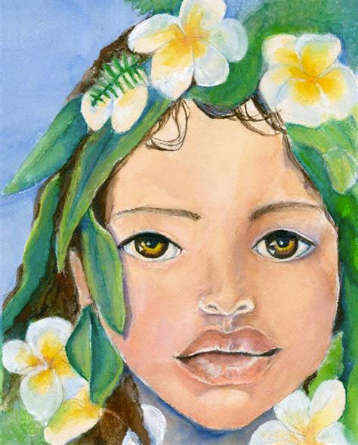
The Early Settlers
Kauai is the oldest of the Hawaiian islands and legend says that the Menehune were the first settlers, followed by the Marquesas in around 400 A.D. The Polynesians arrived around 500 A.D. Other early settlers included dogs, chickens, pigs, and rats, as well as coconuts and bananas that were introduced to the island by the canoe voyagers.
Waimea Town is Kauai`s oldest settlement and capital from ancient Hawaiian days. A statue of Captain Cook stands today in Waimea Town to commemorate the explorers first landing in Kauais Waimea Bay in 1778. Cook`s discovery of what he called the Sandwich Isles, named after the Earl of Sandwich, introduced Hawaii to the world. Whalers and missionaries made Waimea a port of call, and the growth of the agricultural industry in the 19th century brought plantation workers from many nations to the island.
In 1835, Old Koloa Town opened its first sugar mill on the South Shore. Sugar plantation owners contracted immigrant labor from China, Japan, Korea, Spain, Germany, Puerto Rico, Portugal, Norway, and the Philippines. Many of these immigrants settled on Kauai and, as a result, Kauai enjoys a fascinating multicultural society and ethnic diversity. From Tahiti fetes to Bon Dance Festivals, Kauai celebrates and preserves its diverse culture through food, music, dance, mele, and crafts.

Meanings of Names
Hawaiian belongs to the Polynesian family of languages and is related closely to Tahitian, Marquesan, and Maori.
There are only twelve letters to the Hawaiian alphabet, courtesy of the Missionaries who phonetically rendered the Hawaiian language. The consonants are h,k,l,m,n,p, and w. The consonants are pronounced the same as in English; however, the w is often pronounced as a v.
The State of Hawaii consists of eight major islands: Oʻahu, Hawaii Island, Maui, Kauaʻi, Molokaʻi, Lanaʻi, Niʻihau, and Kahoʻolawe.
The State of Hawaii is made up of five counties: Hawaii County, Honolulu County, Kalawao County, Kauaʻi County, and Maui County which includes Maui, Lanaʻi, most of the island of Molokaʻi and the island of Kahoʻolawe.
All of the Hawaiian Islands have various nicknames:
Niʻihau – The Forbidden Isle
Kauai – The Garden Isle
Oʻahu – The Gathering Place
Molokai – The Friendly Isle
Lanai – The Pineapple Island
Kahoʻolawe – The Target Island
Maui – The Valley Isle
The Island of Hawaii – The Big Island
Most visitors have trouble pronouncing the names of places in Hawaii. That’s ok!
Below is a list of meanings for some of the place names on Kauai.
Kekaha – The Place
Waimea – Reddish Water
Pakala – The Sunshine
Hanapepe – Crushed Bay
‘Ele’ele – Black
Kalaheo – Proud Day
Lawa’i – Village
Koloa – Long Sugarcane
Po’ipu – Crashing
Maha’ulepu – Falling Together
Puhi – Blow
Lihu’e – Cold Chill
Wailua – Many Waters
Kapa’a – The Solids or the Closing
Anahola – Easily Broken
Kilauea – Spewing, much spreading
Hanalei – Crescent Bay
Ha’ena – Red Hot
Hanakapi’ai – The Sprinkling of Food
Kalalau – The Straying
Polihale – House Bosom

Early History of Kauai
Kauai, one of the Hawaiian Islands, has a rich and fascinating history dating back thousands of years. The island was first settled by Polynesians around 1,500 years ago, who brought with them plants, animals, and a unique culture. The early inhabitants of Kauai were skilled navigators and seafarers, and their expertise allowed them to explore and settle many of the remote islands throughout the Pacific. They lived off the land, fishing in the sea and cultivating crops on the fertile soil.
Ancient Hawaiian legends tell of powerful chiefs and gods who were said to have once lived on the island, adding a layer of mystery and mystique to the island`s early history. In the late 18th century, Kauai came into contact with European explorers and missionaries.
One of the most famous of these visitors was the British explorer Captain James Cook, who arrived on the island in 1778. His arrival marked the beginning of a new era for the Hawaiian Islands, as European influences began to reshape the island`s society and culture.
In the early 19th century, Kauai was ruled by a series of powerful chiefs, or alii, who competed for control of the island. One of the most famous of these chiefs was Kaumuali`i, who united many of the smaller tribes on Kauai and established a powerful kingdom. However, in 1810, Kauai was conquered by King Kamehameha I of Hawaii, who united all the Hawaiian islands into one kingdom.
The arrival of Europeans on Kauai had a profound impact on the island`s culture, religion, and way of life. Christian missionaries were among the first to arrive in the 1820s, and they quickly began to convert the native Hawaiians to Christianity. The missionaries also introduced new technologies, such as printing presses and written language, which allowed the Hawaiians to document their history and stories for the first time. Despite these changes, the Hawaiian culture and way of life persisted, and Kauai remained a center of Hawaiian culture and tradition.
Today, the island is a popular tourist destination, known for its stunning natural beauty and rich cultural heritage.

The History of Kōloa & Poʻipū: From Sugar Plantations to Sacred Shorelines
Long before Kōloa became a favorite retreat for sunseekers and ocean lovers, it was the site of powerful cultural traditions and a cornerstone of Hawaii’s plantation era. Today, visitors to Kōloa and Poʻipū walk among sacred sites, royal trails, and the remnants of a sugar empire that shaped modern Hawai‘i.
Whether you’re strolling the historic Kōloa Town or watching waves roll in at Poʻipū Beach, you’re experiencing the layered history of Kaua‘i’s South Shore.
🌱 From Ancient Ahupuaʻa to Sacred Land
Hawaiians have lived in the Kōloa area for centuries, carefully stewarding the land through the ahupua‘a system—a traditional division of land stretching from the mountains to the sea. This ensured that each community had access to all resources: freshwater streams, taro fields, and abundant fishing grounds.
The area now known as Poʻipū was once a site of cultural importance, with heiau (temples) and fishponds that sustained ancient Hawaiian society.
🏭 Kōloa Sugar: The Birthplace of Hawai‘i’s Plantation Era
In 1835, Kōloa became the site of Hawai‘i’s first successful sugar plantation, marking the beginning of a powerful and complex chapter in the islands’ history. Operated by Ladd & Company, the Kōloa Plantation laid the foundation for an industry that would dominate Hawaii’s economy for over a century.
The plantation drew workers from around the world—China, Japan, Portugal, the Philippines, and more—contributing to the multicultural tapestry you see on Kaua‘i today.
Don’t miss a walk along the Kōloa Heritage Trail, where interpretive signs share stories of the plantation era and ancient Hawaiian landmarks.
🏘️ Charming Kōloa Town
Historic Old Kōloa Town, with its plantation-style storefronts and shaded walkways, offers a taste of the past blended with island charm. Today’s visitors can explore:
- Kōloa History Center – A small but rich museum detailing the town’s plantation roots.
- Old Sugar Mill Monument – Located at the entrance to town, it commemorates the birth of the sugar industry.
- Historic Buildings – Many of the structures along Kōloa Road are over a century old and now house galleries, shops, and cafes.
🌊 Poʻipū Today: A Coastal Gem with Deep Roots
Poʻipū may be known today for its resorts and beaches, but the land holds generations of history. The Hoʻai Heiau, located in Poʻipū, is one of several sacred sites still standing on the South Shore.
Even your walk along the Mahaʻulepu Heritage Trail takes you past ancient lava formations, fossils, and petroglyphs that whisper stories of the past.
✨ How to Explore the Area’s History
- 🥾 Walk the Kōloa Heritage Trail (self-guided, 14 stops from Spouting Horn to the Old Sugar Mill)
- 🖼️ Visit the Kōloa History Center in Old Kōloa Town
- 🏛️ Stop at Poʻipū’s sacred sites and heiau markers
- 🚗 Take a scenic drive through the sugar cane remnants along Maluhia Road, lined with towering eucalyptus (the “Tree Tunnel”) planted in 1911
Kōloa and Poʻipū are more than beautiful vacation spots—they’re living museums of Hawaiian culture, immigration, resilience, and connection to the land. As you explore, take a moment to look around and imagine the generations who called this place home long before the first traveler arrived.
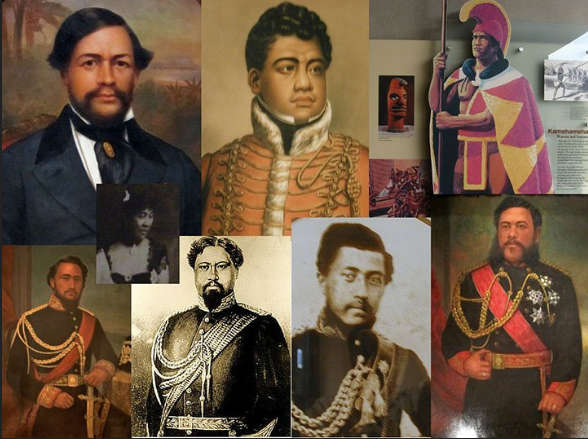
Hawaiian Royalty
Hawaii, known for its stunning beaches, perfect weather, and laid-back way of life, is a place where the past is ever-present. One of the most fascinating aspects of that history is the island`s royal family, who left an indelible impression on Hawaii`s culture, customs, and traditions.
Among the islands, the royal lineages of Kauai are some of the most influential in Hawaiian history. Kauai was ruled by a line of chiefs known as the Kaumuali`i dynasty from around the year 1770 until King Kamehameha I conquered the island in 1810.
The period of Kaumuali`i rule on Kauai was marked by both conflict and collaboration, and the chiefs of Kauai played significant roles in the history of Hawaii. The first king of Kauai was King Kaumualii, who ruled from 1790 until the island was taken by Kamehameha I. Kaumuali`i was known for his diplomacy and shrewdness in navigating the complex political landscape of Hawaii. He made difficult alliances and deals with other rulers that allowed Kauai to flourish in the face of outside threats. One of the most notable examples of Kaumualii`s political savvy was his decision to ally with Liholiho, Kamehameha I`s son and successor, rather than fight him. This alliance secured Kauai`s role as an important player in Hawaii`s political scene until the island became fully integrated into the Hawaiian Kingdom in 1810.
The royal line of Kauai continued to play a significant role in the history of Hawaii even after the Kaumualii dynasty was deposed. Princess Ruth Keelikolani, a direct descendant of King Kaumualii, was a prominent Hawaiian noblewoman known for her adherence to Hawaiian customs and traditions. She was known for her wealth and generosity, and for providing financial and material support for Hawaiian people in need.
The legacy of Kauai`s royal family is still visible on the island today. The famous Grove Farm Sugar Plantation on Kauai, for example, was owned and operated by the descendants of King Kaumualii for many years. And monuments and historical sites dedicated to the royals of Kauai can be found throughout the island. In conclusion, Hawaii`s royal families, and specifically the Kaumualii dynasty of Kauai, played a vital role in shaping the history, culture, and traditions of the Hawaiian Islands. While their direct influence may have waned over the centuries, their impact can still be felt today in the unique spirit of Hawaii itself.
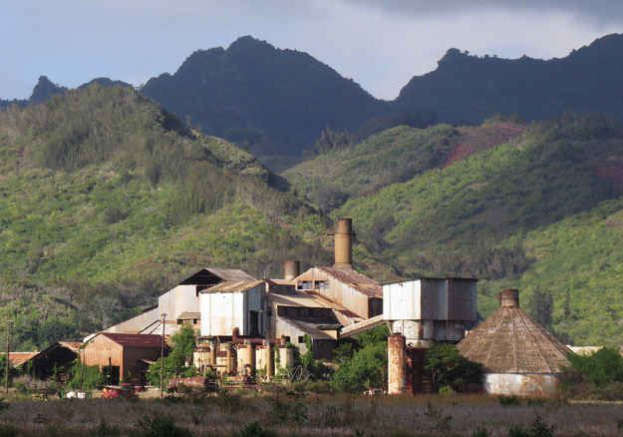
Plantation Days
Kauai`s plantation era, also known as the sugar plantation era, was a defining period in the island`s history. It started in the mid-1800s and lasted until the mid-1900s, transforming Kauai`s economy, society, and culture in profound ways. The plantation era began with the arrival of Westerners, who saw the potential of Kauai`s fertile soil and tropical climate for growing sugar cane. They cleared vast amounts of land, dug irrigation canals, and built mills to process the cane into sugar and molasses. They also imported thousands of laborers from Asia, primarily China, Japan, Korea, and the Philippines, to work on the plantations. The impact on Kauai was significant. The island`s population grew rapidly, with laborers and their families settling in makeshift camps near the plantations.
The plantations became the dominant economic force, providing jobs, land, and basic necessities to their workers. They also created a new social hierarchy, with wealthy plantation owners at the top, managers, and supervisors in the middle, and laborers at the bottom. However, the plantation era was not without its challenges. The laborers worked long hours in harsh conditions for low wages, living in crowded and unsanitary conditions. Many suffered from diseases, malnutrition, and accidents on the job. There were also social tensions between the different ethnic groups, who brought their own languages, cultures, and traditions to the island.
Despite these difficulties, the plantation era had a lasting impact on Kauai`s culture and identity. It brought a diverse mix of people to the island, who contributed to its unique and vibrant melting pot. It also left a legacy of architecture, infrastructure, and technology, such as the historic plantation homes, the irrigation systems, and the sugar mills, that can still be seen today. In the mid-1900s, the plantation era came to an end as the demand for sugar declined, and more profitable crops such as coffee and tourism took their place. Nevertheless, the plantation era remains an important chapter in Kauai`s history, reminding us of the island`s resilience, resourcefulness, and diversity in the face of adversity.
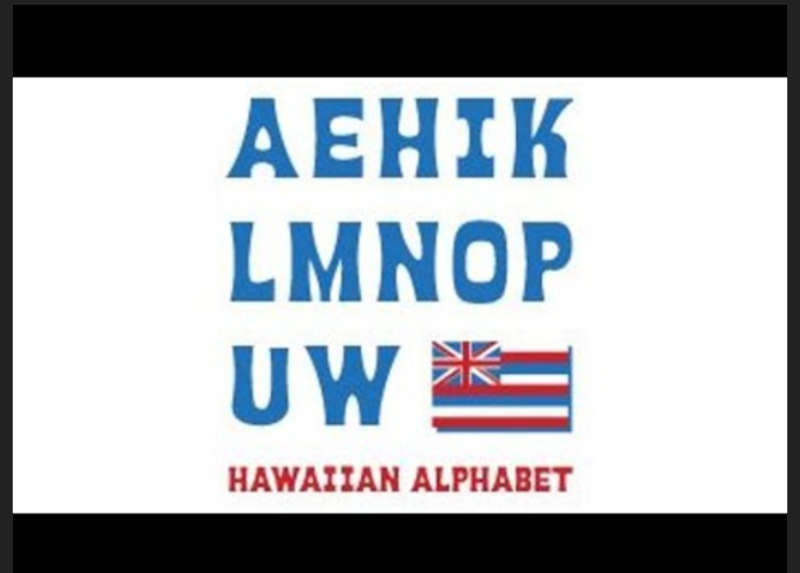
The Hawaiian Language
Hawaiian and English are the official languages of the state of Hawaii. King Kamehameha III established the first language constitution in 1839 and 1840. The Hawaiian alphabet has twelve letters with five vowels (a, e, i, o, u) and seven consonants (h, k, l, m, n, p, w). In Hawaiian, a consonant is always followed by a vowel and thus all Hawaiian words end in a vowel.
Speaking Hawaiian was discouraged and the number of native speakers gradually decreased from the 1830s to the 1950s. There was a worry that the language was going to disappear and it had become endangered. Public Hawaiian language immersion preschools called Punana Leo were first started in 1984 and there has been tremendous growth in Hawaiian speakers and the language is taught in the school system and at the colleges in Hawaii.
The Island of Niihau is the only place in the world where Hawaiian is the primary language and English is considered to be a foreign language.
In the Hawaiian language, a symbol directly over a vowel called a kahako indicates that the vowel sound is to be elongated. An apostrophe-like symbol called an ‘okina indicates a quick pause in the word, as in “ah-ah” for the word a’a. The language is consistent so it is easy to pronounce the words, although their length can be daunting, as long as you memorize the rules.
a is ah, as in far
e is a as in day
i is ee as in see
o is oh as in so
u is oo as in spoon
The most common words used are aloha (a greeting), mahalo (thank you), e komo mai (welcome, come in), hana hou (one more time), often used when watching entertainment and similar to encore. Visitors are familiar with Mele Kalikimaka (Merry Christmas) and Hauoli Makahiki Hou (Happy New Year). Mauka (mountain) and makai (ocean) are referenced when giving directions.

